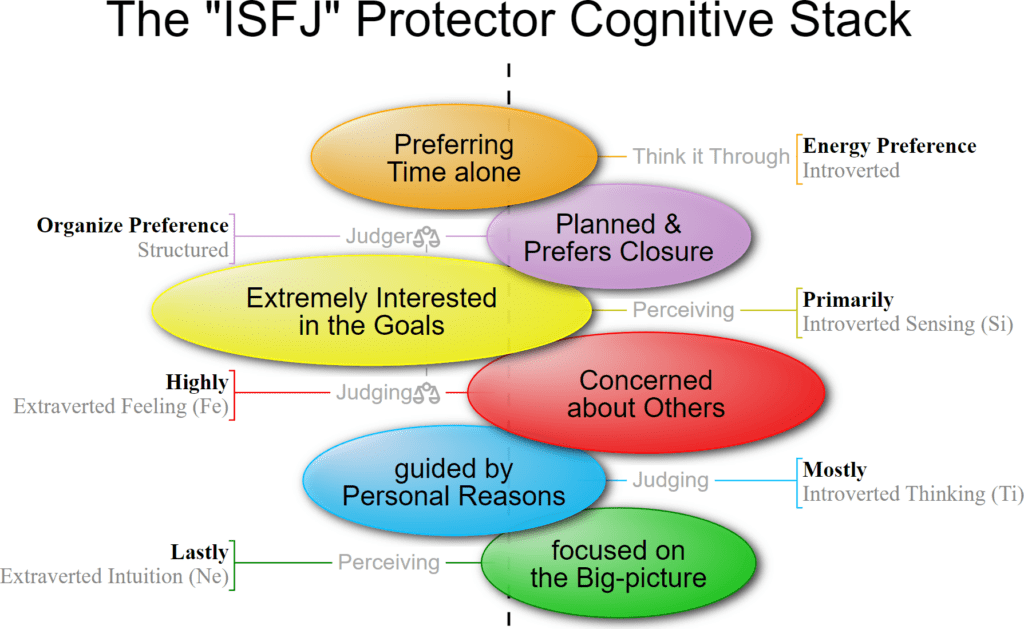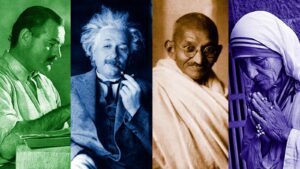What is the Keirsey ISFJ “Protector” Personality Type?
The Keirsey ISFJ “Protector” Personality Type is a Guardian Temperament with a Concrete Communication Style and a Cooperative Action Style.
Keirsey organized the Four Temperaments as a matrix. There are two communication styles, abstract and Concrete, similar to the Myers-Briggs Intuition (Abstract) and Sensing (Concrete) “Perceiving” Cognitive Functions.
And by two action styles: cooperative and utilitarian. Utilitarian people, for the most part, do what works, while Cooperative people do what’s right.
Keirsey named the Four Temperaments as suggested by Plato: Artisan (Iconic), Guardian (Pistic), Idealist (Noetic), and Rational (Dianoetic).

Concrete versus Abstract Communication Style
Keirsey divided the Four Temperaments into two Communication Styles: Abstract and Concrete. These styles resemble the Myers-Briggs Intuition and Sensing “Perceiving” Cognitive Functions.
Some people talk primarily about everyday reality’s external, concrete world: facts and figures, work and play, home and family, news, sports, and weather—all the who, what, when, where, and how of life.
Other people talk primarily about the internal, abstract world of ideas: theories and conjectures, dreams and philosophies, beliefs and fantasies—all the whys, ifs, and what might be of life.
Concrete people talk about reality in their daily lives, while Abstract people talk about ideas.
According to Keirsey, everyone can engage in both observation and introspection. People are observant when they touch objects or otherwise perceive the world through their five senses. When people reflect and focus on their internal world, they are introspective. However, individuals cannot engage in observation and introspection at the same time. The extent to which people are more observant or reflective affects their behavior.
People who are generally observant are more ‘down to earth.’ They are more concrete in their worldview and focus on practical matters such as food, shelter, and their immediate relationships. Carl Jung used the word sensation when describing people who prefer concrete perception.
Generally, reflective people have more ‘heads in the clouds’ and abstract worldviews. They focus on global or theoretical issues such as equality or engineering. Carl Jung used the word intuition to describe people who prefer abstract perception.
Cooperative versus Utilitarian Action Style
Some people act primarily practically or pragmatically; that is, they do what gets results, what achieves their objectives as effectively or efficiently as possible. They only check afterward to see if they observe the rules or go through the proper channels.
Other people act primarily cooperatively or socially acceptable; they try to do the right thing in keeping with agreed-upon social rules, conventions, and codes of conduct. Only later do they concern themselves with the effectiveness of their actions.
These two ways of acting can certainly overlap, but as they lead their lives, utilitarian people mostly do what works, while cooperative people do what’s right.
Keirsey compares the differing temperaments with cooperative (Complying) and pragmatic (Adaptive) temperaments. Cooperative people pay more attention to other people’s opinions and are more concerned with doing the right thing. Sensible people (Utilitarian) pay more attention to their thoughts or feelings and are more concerned with doing what works. No comparable idea in the MBTI or Jung corresponds to this dichotomy, which is a significant difference between Keirsey’s work and Myers and Jung’s.
The pragmatic temperaments are Rational (pragmatic and abstract) and artisan (Pragmatic and concrete). The Cooperative Temperaments are Idealists (Cooperative and Abstract) and Guardians (Cooperative and Concrete). Neither the MBTI nor Jung included the concept of Temperament in their work.
ISFJ Keirsey/MBTI Correlation
| Keirsey | MBTI | |
|---|---|---|
| I | Attentive Role Variant | Introverted Sensing |
| S | Concrete Communication Style | Introverted Sensing Dominate Function |
| F | Informative Role | Extraverted Feeling Auxiliary Function |
| J | Cooperative Action Style | Feeling is a Judging Function |
With Introverted Sensing as the dominant function and Extraverted Feeling as the auxiliary function, the MBTI ISFJ “Protector” Personality Type corresponds to the Keirsey ISFJ “Protector” Personality Type.

ISFJ Personality Type cross-reference
- Keirsey Type – Protector
- Temperament Type – Melancholy
- Animal Type – Beaver
- DISC Type – Compliant
- Socio-Communicative Type – Analytical
- True Colors – Gold
- Color Code – White
- Personality Compass – East
- Occupational Type – Realistic
- Learning Type – Pragmatist
- Leadership Type – Avoider
Enneagram Types
Protector Personality Characteristics
We are lucky that Protectors make up as much as ten percent of the population because their primary interest is in the safety and security of those they care about – their family, their circle of friends, their students, their patients, their boss, their fellow workers, or their employees.
Protectors have an extraordinary sense of loyalty and responsibility in their makeup and seem fulfilled in the degree to which they can shield others from the dirt and dangers of the world.
Speculating and experimenting do not intrigue Protectors, who prefer to use time-honored and time-tested products and procedures rather than adopt new ones.
At work, Protectors are seldom happy when the rules are constantly changing or when long-established ways of doing things are not respected. They value tradition, both in the culture and in their family.
Protectors believe deeply in the stability of social ranking conferred by birth, titles, offices, and credentials. And they cherish family history and enjoy caring for family property, from houses to heirlooms.
Wanting to serve others, Protectors find great satisfaction in assisting the downtrodden and can deal with disability and neediness in others better than any other type.
They are not as outgoing and talkative as the Provider Guardians [ESFJs], and their shyness is often misjudged as stiffness, even coldness. In truth, Protectors are warm-hearted and sympathetic, happily giving of themselves to those in need.
Their reserve is an expression of their sincerity and seriousness of purpose.
The most diligent of all the types, Protectors are willing to work long, hard hours quietly doing all the thankless jobs that others manage to avoid.
Protectors are quite happy working alone; in positions of authority, they may try to do everything themselves rather than direct others to do the job.
Thoroughness and frugality are also virtues for them. When Protectors undertake a task, they will complete it if humanly possible.
They also know better than any other dollar-value type and abhor the squandering or misusing of money.
Saving, putting something aside against an unpredictable future, and preparing for emergencies are actions near and dear to the Protector’s heart.
Protectors are frequently overworked for all these reasons, as they are commonly misunderstood and undervalued.
Famous Protectors
Mother Teresa, George H.W. Bush, Jimmy Stewart, and Tsar Nicholas II are examples of the Protector Guardian style.

What are the Keirsy Personality Temerpaments?

David Keirsey, born in 1921, was an American psychologist specializing in conflict management and family counseling. He began researching human behavior and Personality in the 1940s.
Keirsey blended the Myers-Briggs Personality Types with Ernst Kretschmer’s model of the Four Temperaments, developing the Keirsey Temperament Sorter, which was made famous by his book “Please Understand Me.”
Instead of using the term Personality, Keirsey used Temperament. He viewed it as a configuration of observable Personality Traits, communication habits, patterns of action, characteristic attitudes, values, and talents. To Keirsy, Temperament encompasses personal needs, individual contributions, workplace contributions, and societal roles.
Keirsey correlated the sixteen MBTI Personality Types into Four Temperaments. He divided each Temperament into two Roles: informative and Directive. He subdivided the roles into expressive (extraverted) and attentive (introverted) role Variables.
Informative versus Directive Roles
Keirsey distinguishes between people who generally communicate by informing others versus those who speak by directing others. This distinction subdivides each of the four Temperaments into eight Roles.
Expressive versus Attentive Role Variants
Individuals who act before observing are Expressive. In contrast, people who follow before working are Attentive.
Expressive and attentive variants further subdivide the eight roles into 16 types correlating to the 16 Myers-Briggs personality types.


